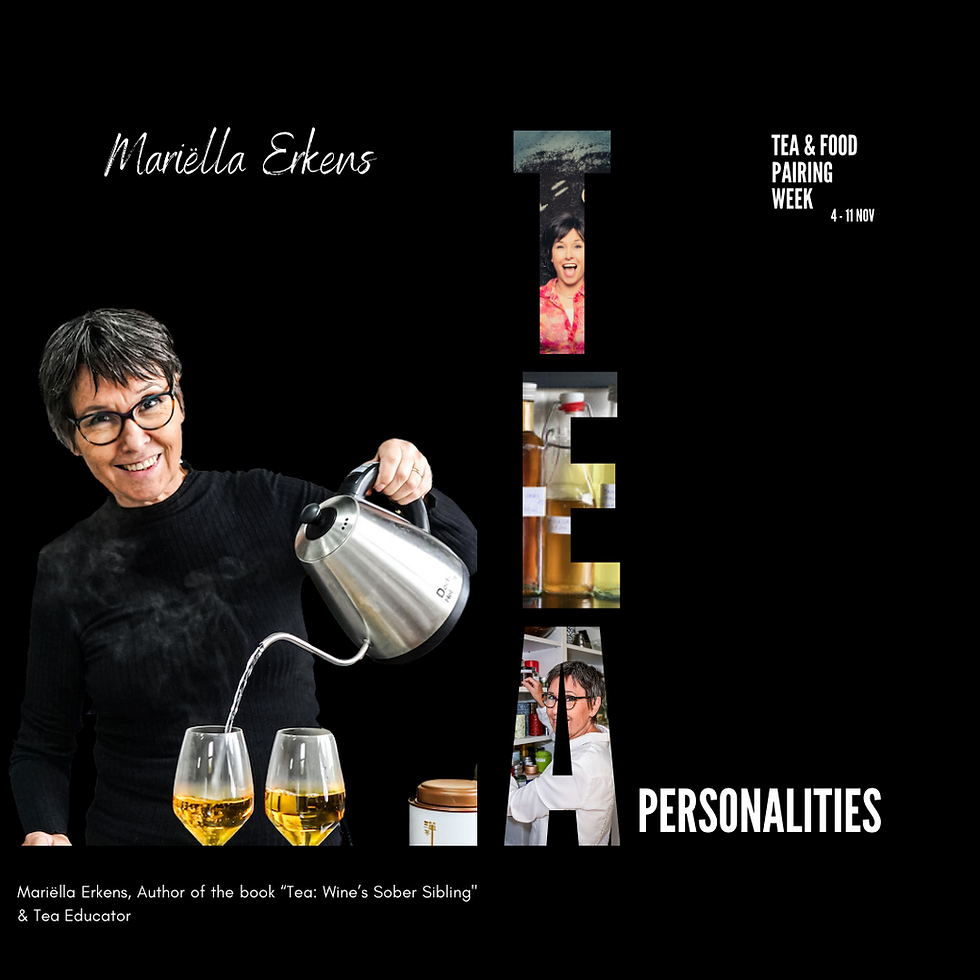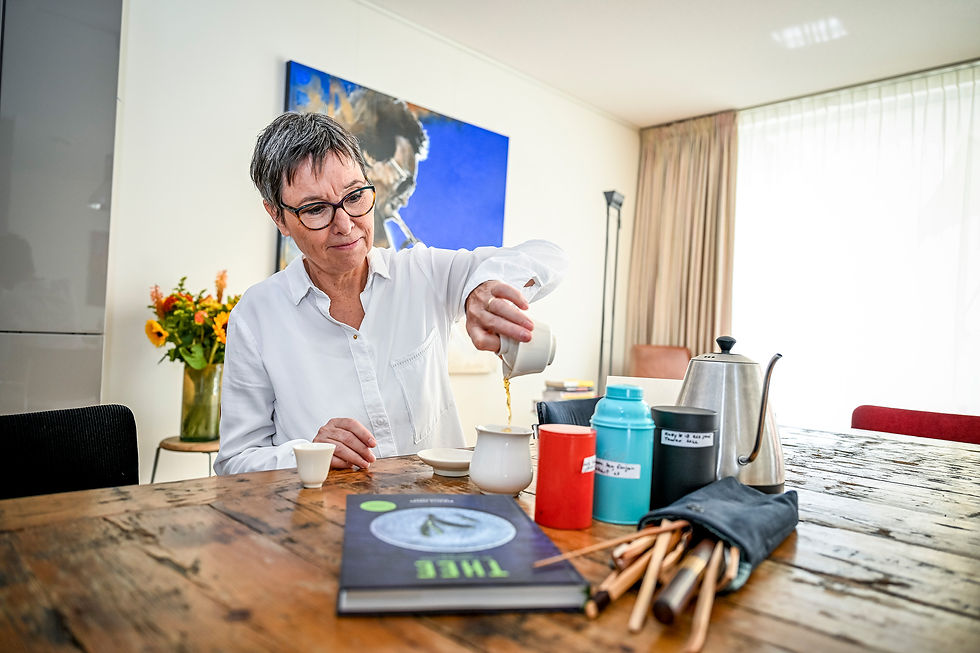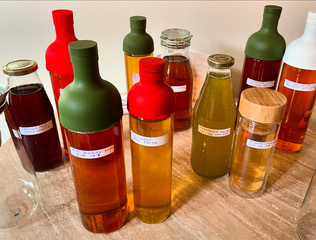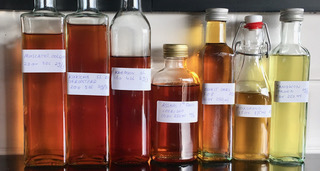Revolutionizing Gastronomy: A Conversation with Mariëlla Erkens on the Art of Tea and Food Pairing
- Lorela Lohan
- Nov 8, 2024
- 7 min read
Introduction
Lorela: It’s a pleasure to have you here today, Mariëlla. Your work as a tea sommelier and author has paved the way for a new understanding of tea in the culinary world. From tea pairings that rival traditional wine pairings to sustainable tea sourcing, you’ve made an incredible impact in an area that often goes unexplored. Thank you for joining us!
Mariëlla: Thank you, Lorela. I’m delighted to be here and have the chance to share more about this journey. Tea truly has a unique place in gastronomy, and it’s been a passion of mine to bring that to light. There’s so much potential in pairing tea with food that I believe could enhance dining experiences and offer new possibilities.

Interview
Lorela: You initially trained as a chef. What was it about tea that made you shift focus, eventually leading you to become a tea sommelier?
Mariëlla: My shift to tea came from an unexpected encounter. While shopping for produce, I attended a workshop on single-origin teas and food pairings, which left a deep impression on me. Up until that point, tea had been something I drank out of habit, never realizing its complex potential. That workshop revealed tea’s ability to complement and elevate flavours in food, much like wine, but with a gentleness that felt unique. From that moment on, I couldn’t stop exploring; I wanted to understand tea in all its depth. This led me to the International Tea and Coffee Academy, where I trained as a tea sommelier. Gradually, my professional life shifted from cooking to tea and food pairing, and now I focus on teaching others about tea’s place in the culinary world.

Lorela: That’s fascinating! You often compare tea to wine in the context of pairing. Could you explain some of the key similarities and differences?
Mariëlla: Definitely. Both tea and wine share terroir—meaning their flavour profiles reflect the soil, climate, and processing specific to their origin. That’s why tea from different regions can taste so distinct. Another similarity is the transformation process; both tea and wine undergo specific processing steps that bring out unique characteristics, like fermentation for wine and oxidation for black tea. However, tea has a subtlety that sets it apart. Unlike wine, which has acidity and alcohol that can sometimes overpower food, tea respects food. For example, tea can add depth, and balance, enhance and/or connect flavours and even create new ones. Tea often complements the food without trying to dominate it.

Lorela: You have such a beautiful way of putting it! Your book on tea and food pairing is quite comprehensive. What inspired you to write it, and what did you want it to achieve?
Mariëlla: Thank you! The inspiration for the book came from a lack of resources on tea and food pairing. I could find Michelin-style recipes with tea pairings, but these didn’t explain why certain teas were chosen for specific dishes. As I began exploring tea, I realized that there was a need for a practical guide that could take people through the basics of pairing, from beginners to culinary professionals. I wanted the book to be accessible yet detailed, so I included over 60 recipes with pairings for different budgets, and sections on pairing tea with cheese, chocolate, and even creating tea cocktails. I hoped to inspire people to experiment and explore tea as a serious pairing option, much like wine.
Lorela: It sounds like an incredible journey. The research must have involved a lot of trial and error. What was the process like?
Mariëlla: It was a journey, that’s for sure! I started by following my chef’s intuition—pairing flavours that I felt would complement each other. Over time, I refined this process, using techniques from wine pairing to create a more structured approach. I learned from Peter Klosse, a wine-pairing expert, who helped me build a framework specific to tea. But of course, tea has its nuances, so some adjustments were necessary. I conducted thousands of tests, and even after I thought the book was ready, I went through six rewrites to make sure everything was clear and practical. There was so much information initially that I had to pare it down; otherwise, it would have been like an encyclopedia!
Lorela: It sounds like a labour of love! Your experience as a chef must have helped in this process. Could you share how it influenced your approach to tea pairings?
Mariëlla: Absolutely. As a chef, I was already familiar with how flavours interact and the balance between acidity, umami, sweetness, and so on. This foundational knowledge was invaluable when I started working with tea, though I hadn’t put formal names to these sensory experiences. When I delved into tea, I realized I needed to develop a language to describe what I was tasting. Peter Klosse’s work helped immensely in giving structure to my intuitive approach, and I adapted his wine-pairing principles to fit tea. With wine, certain flavour elements like acidity and alcohol play a big role, while tea’s subtlety requires a different kind of palate sensitivity. This background as a chef made it easier to approach tea pairings intuitively, which I later refined into a methodical practice.
Lorela: It’s amazing how intuitive it seems for you. Were there any unexpected challenges you encountered while writing the book?
Mariëlla: Oh, quite a few! My biggest challenge was organizing my notes. I had spent years jotting down tasting notes on anything I could find—envelopes, receipts, you name it. When I finally sat down to write, I had a mountain of disorganized thoughts and observations. Sorting through everything and structuring it into a coherent guide was a monumental task. Another challenge was balancing technical depth with accessibility. My chef’s background gave me a head start with flavours, but I had to simplify concepts to make them approachable without losing their essence. I wanted the book to be more than just a reference; I wanted it to be a tool people could use to bring tea into their daily dining experiences.
Lorela: You place a strong emphasis on sustainability. Could you talk about how that shapes your tea selection and philosophy?
Mariëlla: Sustainability is a core part of my philosophy. I always recommend loose-leaf tea over tea bags since bags often involve unnecessary production and waste. Additionally, I advocate for supporting small, single-origin tea farmers. Many of these farmers can’t afford costly organic certifications, but they grow tea sustainably and with great care. I believe it’s better to buy from these farmers rather than larger brands that prioritize profits over ethics. I also encourage minimalist packaging, such as simple brown pouches, which not only reduce waste but also shift the focus onto the tea itself. The goal is to show people that great tea doesn’t need flashy packaging to be exceptional.

Lorela: That’s such an important approach, especially in today’s world. However, consumers are often swayed by marketing. How can we encourage them to prioritize quality over appearance?
Mariëlla: That’s a tough one. Packaging is incredibly influential, but I believe it’s possible to balance aesthetics with sustainability. We can use minimalist, sustainable packaging that communicates quality without excessive design. For example, simple labelling that explains the choice to focus on quality over elaborate packaging can resonate with mindful consumers. It’s about educating people to appreciate what’s inside rather than being swayed by external appearances. Over time, as people gain more awareness, they’ll start recognizing that true quality doesn’t need a lot of fanfare.
Lorela: I noticed you’ve developed a tea extract system specifically for the hospitality industry. Could you explain how it works?
Mariëlla: Yes, the tea extract system proved to be efficient for the hospitality industry at all levels and it’s great for private use too: for home chefs and tea lovers alike. I always have a few bottles of extract ready in my fridge. We create a concentrated tea extract that can be portioned and stored, allowing for quick and consistent service. When a guest orders tea, the extract is poured into a glass, and boiling water is added tableside. This system ensures that each cup is of the highest quality and can be served with minimal fuss. It’s currently being used in places like Bonboon in Amsterdam, and the feedback has been wonderful—employees appreciate the ease and quality. This system also allows unused extracts to be repurposed in sauces or cocktails, so there’s minimal waste. It’s a win-win for both the restaurant and the diner.
Lorela: It sounds like a game-changer for fine dining! Are there any current trends in the tea world that you’re particularly excited about?
Mariëlla: I’m glad you asked! There’s been growing interest in tea as an ingredient in cold brews and tea-based cocktails, which adds a creative twist to menus. These trends are exciting, especially for warmer months. However, I still believe that warm tea offers the best pairing experience for most foods. Warm tea brings out the depth of flavours, which allows the tea and food to complement each other beautifully. It’s wonderful to see chefs and restaurants starting to experiment with tea, even if the journey to fully incorporate it is still ongoing.
Lorela: Finally, what’s next for you, Mariëlla? Are there any exciting projects on the horizon?
Mariëlla: I’m currently working on a new book that focuses more specifically on the tea extract system and its use in food pairing. This will allow me to go deeper into the techniques and applications for chefs and hospitality professionals. I’m also continuing with in-person workshops, as I find that hands-on experiences are invaluable for truly appreciating tea’s complexities. And yes, I have some media appearances coming up, which I’m excited about because it helps reach a wider audience. Ultimately, my goal is to keep inspiring others to explore the potential of tea in their culinary experiences.
Conclusion
Lorela: Thank you so much, Mariëlla, for sharing your journey and insights with us today. Your passion for tea is infectious, and it’s inspiring to see how you’re transforming tea’s role in gastronomy. I’m sure many of our listeners will be curious to try tea pairings after hearing from you. I also recommend purchasing this book: it is a masterpiece for those interested in pairing tea and introducing it to their menus.
Mariëlla: Thank you, I hope more people feel encouraged to explore tea beyond the teacup and into the culinary world. There’s so much joy and discovery waiting in tea, and I’m excited to see where it takes us.
All photos were credited by Mariëlla Erkens





コメント